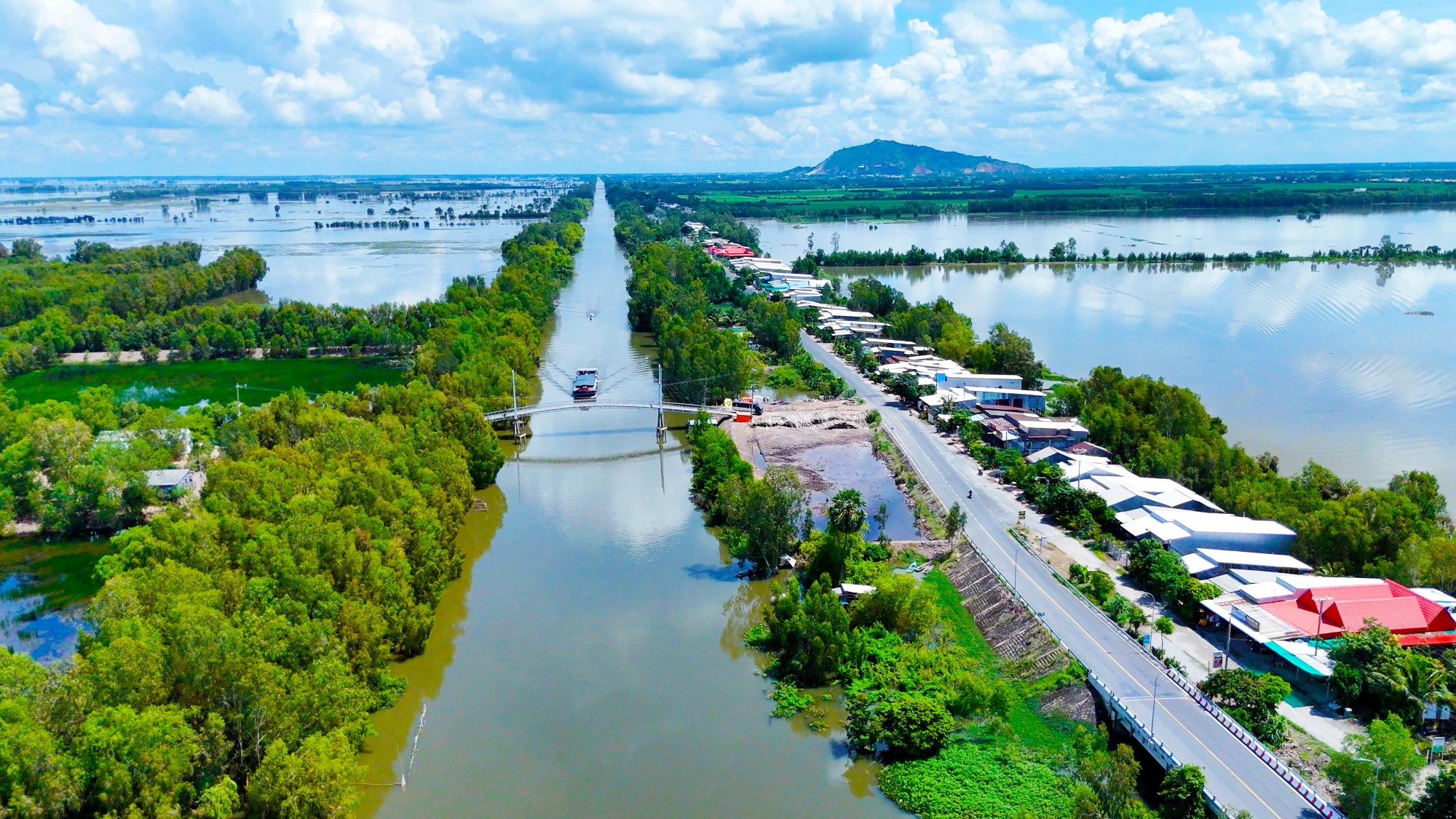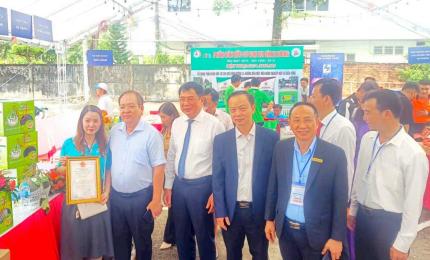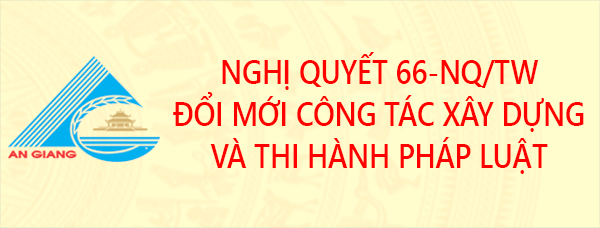The canal digging process lasted 5 years: 1819 – 1824. Vinh Te Canal - a historical project of great stature in the Southwestern border of Vietnam, became a testament to the perseverance and creativity of our ancestors in the work of reclaiming land and protecting sovereignty. Carried out through three construction phases over 5 years, Vinh Te Canal is not only a strategic traffic route but also a symbol of the nation's indomitable spirit.
Photo: Phan Huu
Phase 1: Challenging Start-up
The Vinh Te canal project started the construction on the 15th day of December lunar month in Ky Mao year (1819), under the command of Nguyen Van Thoai Governor, along with other commanders such as Chuong Co Nguyen Van Tuyen and Dieu Bat Nguyen Van Ton. Right from the beginning, there were 5,000 workers recruited from Vietnamese civilians and soldiers and 500 others serving in the Uy Vien Don army, each month providing each person with 6 coins of money and 1 “phương” of rice. Particularly Dieu Bat Nguyen Van Ton mobilized 5,000 people from Chan Lap people soldiers, each month providing each person with 6 coins of money and each person with one “vuông” of rice.
Digging the Chau Doc - Ha Tien canal this time encountered many more obstacles than the digging of Dong Xuyen - Rach Gia canal. Mobilizing a large force of civilians and soldiers, both Vietnamese and Chan Lap people, to serve the canal digging in the condition of lacking in all aspects, from materials and tools for digging the canal, to food and drink, and even medicine when the canal diggers got sick or had accidents while working, including cases of being attacked by wild animals, bitten by snakes and centipedes, and mosquitos everywhere. The erratic climate with many poisonous gases greatly affected the progress of the canal digging. The canal digging work started on hard ground with 7,575 fathoms (17,398m) dug by the Vietnamese; there were also some straight lines with a length of 18,704 fathoms (47,887.24m), but with easy-to-dig and soft soil dug by the Chan Lap people. The canal width is 15 fathoms (38m) and 6 feet (1.536m) deep. The first phase of the canal digging lasted three months from the full moon of December in the year of Ky Mao (1819) to the full moon of March in the year of Canh Thin. During each canal digging phase, there were small phases that were rotated between the workers. According to records, this phase of the canal construction from Chau Doc to Ca Am (present-day Tinh Bien) was about 20 km long.
Phase 2: Canal Expansion
After a two-year hiatus, in February of Quy Mui year (1823), the second phase of the Vinh Te canal construction was started. Under the order of King Minh Mang, Gia Dinh Governor Le Van Duyet mobilized more than 39,000 soldiers and civilians in the citadel and the towns of Vinh Thanh, Dinh Tuong, and Uy Vien garrison, along with more than 16,000 soldiers and civilians of Chan Lap country, and provided money and rice every month as in the Gia Long period. The Gia Dinh citadel collected 6 quan of money and 1 phương of rice every month from the people, and every 5,000 people appointed 150 officials who received 1,000 quan of money and 150 phuong of rice. The Chan Lap people contributed 4.5 quan of money and 1 phuong of rice every month, and every 5,000 people appointed 100 leaders of the local administration, and they received 1,000 quan of money and 150 phuong of rice. Not long after, Le Van Duyet fell ill, and the King assigned Deputy Governor Truong Tan Buu to replace him.
The civilian militia divided into 3 shifts to operate. But from spring to summer, the canal digging work continued to be postponed due to drought. During this period, in addition to the great contribution of Deputy Governor Truong Tan Buu, there were also Marshal Nguyen Van Tuyen and Marshal Tran Cong Lai assisting Thoai Ngoc Hau. With such a large number of mobilized workers, after 3 months of construction, the canal was dug for about 60 km, the remaining part was about 1060 “trượng” (equivalent to 3.5 km). The work of commanding the militia to dig the Vinh Te canal phase 2 ended.
Phase 3: Completion of Historical Project
The last phase was carried out in February of Giap Than year (1824), the remaining length of the canal was only 1,700 trượng (4,352m) from the end of Giang Thanh canal. The canal digging was carried out actively with the support of Deputy Governor Tran Van Nang and up to 25,000 civil soldiers, including Chan Lap and Vietnamese people, digging day and night, and was completed on May 01, 1824. The Vinh Te canal was completed, and Gia Dinh citadel reported to the capital. King Minh Mang said: "Digging that river to complete the previous work, it is truly a benefit for thousands of years to come. He then ordered the authorities to erect a stele to record it". Thus, with intelligence, a spirit of persistent, steadfast but creative labor, our ancestors created a magnificent work in the S+outhwestern border region in the early 19th century. The completion of Vinh Te Canal marked a new period of development for land reclamation, the establishment of plantations and villages in the border area. At the same time, Vinh Te Canal appeared as a giant trench protecting and affirming national sovereignty on the Southwestern border. As King Minh Mang said: "It is truly important for national border planning".

Historical Value and Importance of Vinh Te Canal
Vinh Te Canal not only played the role of an important trade route, supporting land reclamation, but also a solid trench protecting the national border. The project created a new period of development in the Southwestern border region, helping to establish many plantations and villages, contributing to the long-term prosperity of this land.
Today, Vinh Te Canal remains a symbol of the Vietnamese people's perseverance, intelligence, and working spirit, reminding next generations of the sacrifices and tireless efforts of our ancestors in building and defending the country.
Excerpt from "Propaganda outline for the 200th anniversary of the completion of Vinh Te canal (1824 - 2024) and the 198th anniversary of the death of Mrs. Chau Thi Te (1826 - 2024)"
Source: tuyengiaoangiang.vn
Translation by Hoang Oanh


























